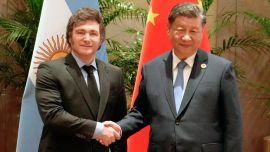President Javier Milei’s recent attempt to repeal current legislation and remove the 15-percent cap on the foreign ownership of land has revived debate in Argentina. Within that framework, Perfil has drawn up a list of the 20 biggest landowners holding over 100,000 hectares of national territory.
The list is headed by the oil company High Luck Group, financed by Chinese capital, to whom 1.14 million hectares have been leased. They are followed by the 920,000 hectares held by the Compañía de Tierras del Sud, of the Italian Benetton Group.
Touching on fields of the fertile pampas, sweeping national landscapes, vast mining areas and more, the list continues until closing with the just over 105,000 hectares owned by billionaire Eduardo Eurnekián’s firm Corporación América.
Assembling the list
At 9am on September 7, 2022, this reporter was en route to San Isidro. The trains heading to Retiro were jam-packed, but not so much in the opposite direction. It was not hard to find a seat to pore over the information compiled in the previous week – in a few minutes this newspaper would be conversaring with the owner of 170,000 hectares of national territory, an amount of terrain around 8.5 times larger than the nation’s capital, Buenos Aires City.
Sergio Rostagno is a lawyer who divides his time between the northern suburbs here and the province of Mendoza, where his fields lie. He was not hard to locate: in the Malargüe zone he is a well-known personality and making direct contact did not take long. Such people might be a small or medium-sized businessman, an accountant or a newsvendor, but in the final analysis they are landowners.
Rostagno owns El Palauco, a field of 170,000 hectares placing him on the list of landowners published by Perfil. The aim of that meeting was to check information previously acquired about that land, especially the number of hectares. Data had emerged from press sources, documentaries and the real-estate sector pointing to at least 150,000 hectares.
At the start of that conversation, Rostagno wasted no time in referring to that land in the form of some wishful thinking: "I’d like to swap that Mendoza field for 1,000 hectares in La Pampa because everything there is more ordered."
This newspaper asked him to go into more depth. His answer forcefully raises an issue permeating the land debate, namely the claims of indigenous communities to their ancestral ownership which are – for the most part – mostly pressed along the Andes. Press cuttings on the Internet reflect a series of conflicts featuring denunciations of illegal occupations and the consequent evictions.
Rostagno’s explanation highlighted "pseudo-indigenous peoples."
"The whole conflict started in 2004 when some brand-new vans circulated around the fields urging tenants to pass themselves off as indigenous people and stop paying rent. From then on many did just that, even though there were ongoing rental contracts. We took it to court and obtained a [favourable] ruling but it could not be enforced against indigenous peoples," the lawyer told Perfil.
To that answer may be added another, one which would reappear again and again in future interviews with managers or owners of landholdings along the Andes: the geographical difficulties in defining the limits of fields of such size that crisscross several provincial and national highways.
Rostagno’s answer also highlighted another doubt. Unlike most of the cases surveyed, El Palauco was one of the few not linked to an agribusiness or mining company. There was no information as to the use made of the land nor the history of those Andes foothills that are full of rivers and creeks. Its owner, however, wasted no time in explaining that they were not exploited fully. Many plots are leased to peasants of the zone and are dedicated to small farms or cattle.
According to Rostagno, the reason why El Palauco has remained an undivided condominium was the legal impossibility of redistributing the fractions corresponding to himself and the two other partners that formed El Palauco SA. As to the origin of the land, he detailed that it had been purchased by the great-grandfather of one of his ex-partners at a state auction in 1912.
During the conversation, Rostagno did not hesitate when confirming the concrete figure Perfil had come looking for.
"More or less 170,000 hectares," he said. He also mentioned a detail which had not previously cropped up – in 2009,103 hectares were donated for a European Space Agency base, which installed a huge parabolic antenna that transmits data and carries out exploratory missions and scientific experiments.
Selecting cases
The meeting with Rostagno was but one of dozens of appointments, telephone calls, video conferences and emails exchanged with real proprietors, real-estate agencies, national and provincial government offices and representatives of different companies.
The investigation began last September. Once the idea was planted, the aim was to check up on the main figures, the number of hectares, while obtaining basic information of interest regarding the proprietors, the uses of the land and its geographical location, marking out the particularities of each case. The parameter of selection was the possession of over 100,000 hectares, whether directly owned or temporarily leased, by proprietors both local and foreign.
At that time, Javier Milei was a deputy still far removed from winning any presidential election and far less from signing any massive deregulatory emergency decree, including repeal of the strategic land law which, following its approval in 2011, has sought to cap foreign land ownership at 15 percent of the total surface of Argentine territory (with the same cap applied at provincial and departmental level while working in equivalencies in terms of the productivity of the land). On the one hand, the law set limits, but on the other it also recognised that a hectare of land in Santa Cruz and in the fertile pampas is not the same thing.
The law further created the National Register of Rural Land, entrusted with administering the quotas of foreign ownership. One of the first steps of our work was to draft a request for access to public information with the aim of obtaining a state response as to who owned fields of over 100,000 hectares but this instrument never took off. On an off-the-record basis, the office to which our request was directed promptly notified us via informal contacts that access to this information would not be possible as consisting of reserved data. The same response was received in successive requests for access to public information sent to different provincial offices in Mendoza, San Juan and La Pampa, among other provinces.
When this newspaper understood that at official level there was nothing doing, we had to turn to artisan methods with a case-by-case search which, in general terms, was easier with land in the hands of private companies. Most of them state this information in their websites, along with details of location and use, ratifying this information in reports on management and/or sustainability addressed to the state or investors.
But as in the case of El Palauco, on the list, the names of firms with every appearance of being "ghost" companies appeared without any web pages or data respecting their potential proprietors while scarcely mentioned in press archives.
One of those was Estomonte AG, given in various articles as owning 400,000 hectares in the Cuyo midwest. Obtaining the exact figure demanded months of reviewing documents, telephone calls and emails without reply. The answer finally appeared as a land surface measuring 404,098 hectares within voluminous civil documentation lodged in the San Juan federal courtroom. The firm appears to be an offshore company based in Switzerland, which several years ago sued another company owning a neighbouring field for deciding to sell off land without resolving a boundary dispute beforehand. Here the problem of the demarcation of land around the Andes again crops up since the field is located in Calingasta, San Juan Provinces.
This method was repeated case by case, not just for the 20 finally appearing in the printed list but also for dozens of others that were ruled out for different reasons – either because the information as to their hectares could not be checked out or because the fields were split up and sold off. There was even the paradigmatic case of Lázaro Báez, who formed part of a select group of landowners who, because of the legal cases against them, saw their lands auctioned off or placed at the disposal of federal judges.
That was the idea behind the assembling of a list of the 20 biggest landowners, producing information which could prove a more than useful tool for understanding the interests behind the recurrent land debate.





















Comments